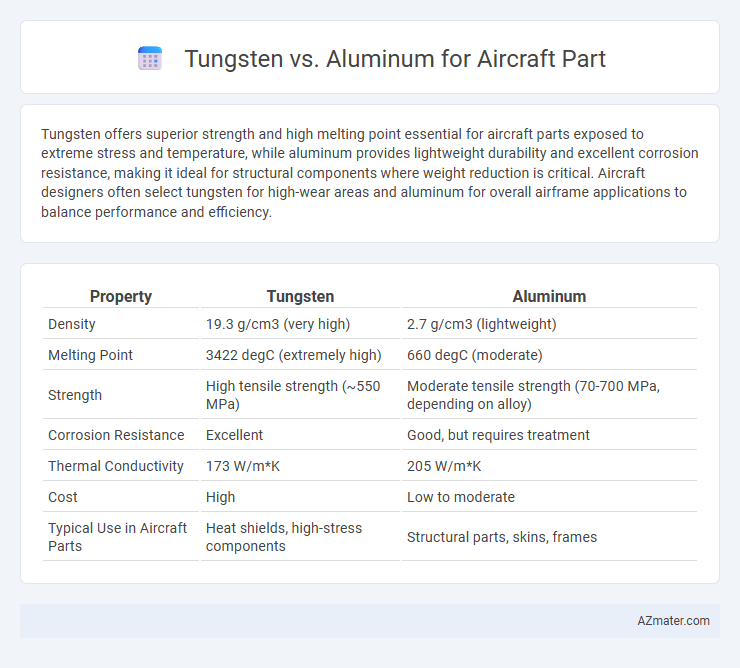Tungsten offers superior strength and high melting point essential for aircraft parts exposed to extreme stress and temperature, while aluminum provides lightweight durability and excellent corrosion resistance, making it ideal for structural components where weight reduction is critical. Aircraft designers often select tungsten for high-wear areas and aluminum for overall airframe applications to balance performance and efficiency.
Table of Comparison
| Property | Tungsten | Aluminum |
|---|---|---|
| Density | 19.3 g/cm3 (very high) | 2.7 g/cm3 (lightweight) |
| Melting Point | 3422 degC (extremely high) | 660 degC (moderate) |
| Strength | High tensile strength (~550 MPa) | Moderate tensile strength (70-700 MPa, depending on alloy) |
| Corrosion Resistance | Excellent | Good, but requires treatment |
| Thermal Conductivity | 173 W/m*K | 205 W/m*K |
| Cost | High | Low to moderate |
| Typical Use in Aircraft Parts | Heat shields, high-stress components | Structural parts, skins, frames |
Introduction to Tungsten and Aluminum in Aerospace
Tungsten and aluminum serve distinct but critical roles in aerospace engineering due to their unique physical properties. Tungsten offers exceptional density and melting point, making it ideal for components requiring high thermal resistance and structural weight to balance aircraft systems. Aluminum's lightweight characteristics, corrosion resistance, and high strength-to-weight ratio contribute to its widespread use in airframe structures and fuel-efficient aircraft design.
Material Properties Overview: Tungsten vs Aluminum
Tungsten offers exceptional density and hardness, with a melting point of 3422degC, making it highly resistant to heat and wear, essential for high-stress aircraft components. Aluminum excels in lightness, with a density of about 2.7 g/cm3 compared to tungsten's 19.3 g/cm3, providing superior strength-to-weight ratio critical for fuel efficiency and maneuverability. Thermal conductivity in aluminum (around 235 W/m*K) surpasses tungsten's (approximately 173 W/m*K), enhancing heat dissipation in aircraft parts exposed to variable temperatures.
Weight Considerations for Aircraft Parts
Tungsten's density of approximately 19.25 g/cm3 significantly outweighs aluminum's lighter 2.7 g/cm3, making aluminum preferable for aircraft parts where minimizing weight is critical for fuel efficiency and performance. Despite tungsten's superior strength and thermal resistance, its heavy mass often limits its use to specialized, small components rather than structural parts. Aluminum alloys strike an optimal balance between strength-to-weight ratio and corrosion resistance, driving their widespread adoption in the aerospace industry.
Strength and Durability: Comparing Performance
Tungsten exhibits superior strength and hardness compared to aluminum, making it highly resistant to deformation and wear in critical aircraft components. Aluminum, while lighter and more corrosion-resistant, generally lacks the durability and tensile strength required for high-stress parts subjected to intense mechanical loads. For aircraft applications demanding exceptional structural integrity and long-term durability, tungsten alloys provide enhanced performance despite their higher density and cost.
Corrosion Resistance and Environmental Factors
Tungsten exhibits superior corrosion resistance compared to aluminum, maintaining structural integrity in harsh environments with minimal oxidation or degradation. Aluminum, while lightweight and commonly used in aircraft parts, is more susceptible to corrosion, especially in saline or humid conditions, requiring protective coatings or treatments. Environmental factors such as marine exposure accelerate aluminum corrosion, whereas tungsten's dense and stable oxide layer provides enhanced durability in challenging aerospace applications.
Machinability and Manufacturing Processes
Tungsten exhibits poor machinability due to its high density and hardness, requiring specialized tooling and slower machining speeds, which increases manufacturing time and costs compared to aluminum. Aluminum offers excellent machinability with its lighter weight and ductility, enabling faster cutting, drilling, and forming processes ideal for complex aircraft components. Manufacturing processes for aluminum are more versatile and cost-effective, making it the preferred choice in aerospace applications where weight reduction and efficient production are critical.
Cost Efficiency and Availability
Tungsten offers superior strength and high melting points, but its high cost and limited availability reduce cost efficiency for aircraft parts. Aluminum is lightweight, widely available, and more affordable, making it the preferred choice for cost-effective mass production in aerospace manufacturing. The trade-off between tungsten's performance benefits and aluminum's cost and accessibility often guides material selection based on specific aircraft design requirements.
Common Aircraft Applications for Tungsten and Aluminum
Tungsten is commonly used in aircraft components that require high density and strength, such as counterweights, vibration dampers, and ballast blocks in control surfaces and landing gear. Aluminum dominates structural applications due to its favorable strength-to-weight ratio, corrosion resistance, and ease of fabrication, making it ideal for fuselage panels, wing skins, and airframe frames. The complementary use of tungsten and aluminum in aircraft designs enhances performance by balancing weight, durability, and structural integrity in critical parts.
Safety and Regulatory Compliance
Tungsten offers superior density and melting point compared to aluminum, enhancing aircraft part safety by providing exceptional fire resistance and structural integrity under extreme conditions. Aluminum's lightweight properties improve fuel efficiency but require stringent regulatory compliance for fatigue and corrosion control to maintain airworthiness. Both materials meet FAA and EASA standards, yet tungsten parts often undergo rigorous testing for high-temperature performance and impact resistance to ensure adherence to safety regulations.
Choosing the Right Material for Your Aircraft Component
Tungsten offers exceptional strength and high density, making it ideal for aircraft parts requiring maximum durability and impact resistance, such as landing gear components. Aluminum provides a lightweight solution with excellent corrosion resistance and good strength-to-weight ratio, suitable for airframe structures and panels where weight savings are critical. Selecting the right material depends on balancing strength requirements, weight constraints, and environmental exposure specific to each aircraft component.

Infographic: Tungsten vs Aluminum for Aircraft Part
 azmater.com
azmater.com